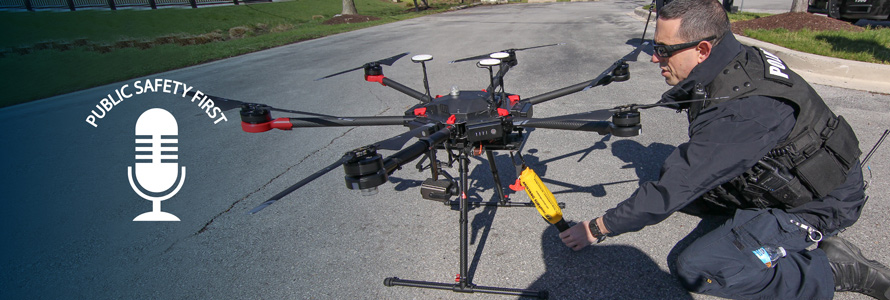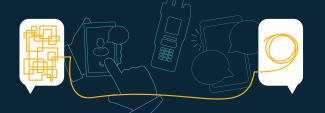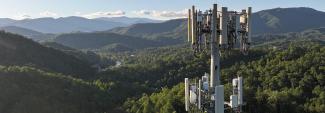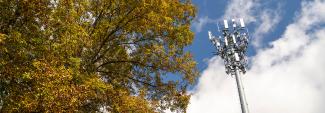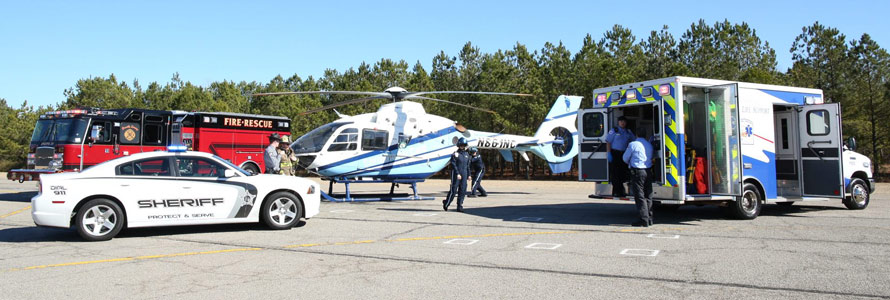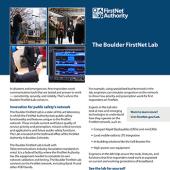Summary
The Wilmington Police Department in Delaware serves the state’s largest city. Recognizing the need for more efficient and effective aerial video capabilities, the agency invested in unmanned aerial vehicles (drones) in 2014. The agency relies on FirstNet to stream video footage from the drones back to the ground in real time, providing responders with critical information to make in-the-moment decisions.
Guest
Lori Stone
FirstNet Authority Senior Public Safety Advisor
Master Sergeant Adam Ringle
Director of UAS Flight Operations, Wilmington Police Department, Delaware
Transcript
Preview
Narrator: You're listening to Public Safety First, a podcast to help you learn about the First Responder Network Authority and how you can be part of the future of public safety technology.
And now, your host.
Narrator: You're listening to Public Safety First, a podcast to help you learn about the First Responder Network Authority and how you can be part of the future of public safety technology.
And now, your host.
Lori Stone: Welcome to the Public Safety First podcast. I'm Lori Stone, and I'm a Senior Public Safety Advisor at the FirstNet Authority. Today, I'll be talking with Master Sergeant Adam Ringle of the Wilmington Police Department in Delaware about his agency's drone program and about how FirstNet is supporting their operations. Master Sergeant Ringle serves as the Director of Unmanned Aerial Systems [UAS] Flight Operations for the department, and he's the pilot in charge of the UAS aircraft program. Master Sergeant Ringle, thank you so much for joining us today. Could you start off by telling us a little bit about your background and your role overseeing the drone program?
Master Sergeant Adam Ringle: My name is Adam Ringle. I've been with the Wilmington Department of Police for 25 years and I've been serving as the Director of UAS Flight Operations for the last seven or eight years. And I currently oversee that and the Forensic Services Unit.
Lori Stone: Tell us more about Wilmington Police Department's UAS program. When did it begin and why did the department start investing in drones?
Master Sergeant Adam Ringle: So, our drone program started in 2014 and it sort of started by accident. I used to be the guy that would hang out of helicopters and take pictures for crime scenes and court purposes. And one year I had $1,500 left in my budget and I decided that a flying camera would be a lot easier than a flying Adam. So, we decided to use a drone to start taking pictures for court and other legal purposes internally and externally.
Lori Stone: And your department's had success now during major events, including the Democratic National Convention [DNC] programming that was in Wilmington and then again during the election night programming when President Biden accepted the nomination. Tell us more about how you leveraged that technology during those events.
Master Sergeant Adam Ringle: Well, as you can imagine, those events are large scale events and they require lots of support elements. One of those types of elements includes air support, whether it's by helicopter or by drone, in this case. So, my task was coordinating and providing the air support for the DNC first. And we learned a few lessons during the DNC, which were helpful. It established how we were going to do things such as send video feeds back and forth, etc., and the capabilities of our current cellular provider and other wireless transmission devices that are needed to utilize a drone to be a benefit to the command post and others watching it. So, during those events, we had multiple aircraft flying all the time. And as you can imagine, multiple aircraft, multiple video feed. So, there's a lot going on to manage. But it provides a safe buffer for our officers. It provides a good safety net for the command post because typically they can see things before they occur and the drones are significantly cheaper to operate than manned aviation. And we're able to keep eyes in the sky, so to speak, at any given time during the event with just some electricity, batteries, a generator and the usual stuff. So, it was very helpful. And we're able to respond to crisis events during those situations quite easily.
As far as scale, for both events, we had just a little under one square mile of aerial patrol area. And during those times, it eliminates a lot of radio traffic by the commanders, just by being able to see the drone. And one of the unique things about them seeing it is they're able to direct the camera left, camera right, do those things. So, it really increases the level of safety for people attending those events, people coming and going, and you're able to see traffic management conditions in real time.
So, there were five times more people for the election than there were for the DNC. And the DNC was not as congested, cellularly-speaking. So, our service provider at that time, it worked OK, but it didn't work to the level we had liked. And when we went to the election week where we were working 16-hour days and we didn't know when the election was going to be over, we were able to facilitate providing that high-level service for the entire event.
Lori Stone: It sounds like you and your team were very busy. About how many drone flights did you lead during that time?
It was a significant amount of flights we did. During the election week, we did 88 missions and we had almost 45 hours of actual flight time. We did, I think, eight total flights for crisis mitigation and two of them we did for mutual aid outside the perimeter for significant traffic issues on the major thoroughfares coming and going from the hard perimeter area. So, having that ability to send those video feeds to other places is priceless in those congested conditions, so to speak. It was a huge benefit to be able to send the drone ahead in packed crowded areas and get an overhead view and the command post is able to see it in real time. When we responded to crisis events, we were able to mitigate and determine whether they were, in fact, actual crisis events and the stakeholders and the tactical in the Joint Operations Command Center, they're able to all see that in real time and make those critical decisions based on the technology we're using. And that was pretty much the consistency for both those events. It was just on a much larger scale for the week of the election.
Lori Stone: Now, you mentioned seeing situations in real time. Are you live streaming the video back to your —
Master Sergeant Adam Ringle: Yes.
Lori Stone: — crisis command center?
Master Sergeant Adam Ringle: Yes. So, we do that in a kind of a tiered process. So, not only do we live stream it to the command post, the traffic management center, or whoever needs to see it for an event of that magnitude, the other thing that we do is we have our own live feed monitor. We bring a 50-inch monitor with us in our own flight crew area. So, that way we can also dedicate a crew member to watch the video feed because after hours and hours of flying and eye fatigue, we want to make sure, for those critical events, that we're not missing anything as far as on watching it on a seven-inch screen, so I guess you could call it QA/QI [quality assurance/quality improvement] process on ourselves in real time to make sure that we're not missing anything. But, yes, that is done through a live feed process.
We use a third-party app to do that. And the third-party app works with our UAV [unmanned aerial vehicle] feeds and it takes the UAV feeds and we can transmit up to six of them at any given time. And we had five aircraft total for both events. So, we're able to do that in real time and send it to multiple places without any difficulty utilizing that app. It also gives us warnings with regard to the health and safety of the UAV. If something pops up that's critical that we need to land, it alerts us for that as well. So, it's very beneficial using it in real time. But using those things in real time obviously requires a lot of bandwidth. It requires a lot of capability set on our service provider. And unfortunately, at the time of the election, that was a lesson that we learned the hard way, which led us to where we are now. And unfortunately, at the most critical times, we had a UAV response for a possible suspicious device during the election event. And the UAV feed, at times, was in and out strictly because of the amount of cellular saturation in the area. As I mentioned, the crowd was five times larger during the election week and especially on the last night, which was the most critical night. So, if you measured it in criticality against our, you know, current service provider, the criticality versus the output – as the criticality rose, the output diminished because of the cellular saturation. So, that presented us with some challenges.
Lori Stone: So, tell me, Adam, how is FirstNet supporting the work that you're doing with drones?
Master Sergeant Adam Ringle: So, since that time, we have left our current provider and went to FirstNet right after the election event. And the direct communication process that FirstNet enables with public safety agencies, that part of the process in itself is like nothing we've ever experienced before. And it's extremely helpful because, you know, any cellular service has good and bad. But the issue that makes a critical difference here is that when things are not perfect, you're able to get a hold of somebody in real time and let them know that it's not perfect and adjustments can be made. So, one, the support is very, very good when in comparison to other types of services that are providing, you know, supposedly the same level. And we are able to stream five, six drone feeds using a couple of FirstNet devices, instead, with our previous provider, where we would have to allocate one device per UAV to transmit those feed successfully as the saturation level rose. And the unique feature of FirstNet is the Band 14 and the preemption, allowing us to continue, as the criticality rises, the service can keep up with that need and not shut us off like we would be on a commercial or consumer band. And it has absolutely changed the way we are able to stream and send the drone feeds here, there and everywhere in real time. And again, if you can't deliver at the most critical moments of your response, then what's the point of having that technology? It doesn't help.
Lori Stone: And how is technology like this changing law enforcement operations?
Master Sergeant Adam Ringle: Well, I think everyone, kind of, takes a deep breath before we go into things, where, you know, maybe five, 10 years back, we would kind of hit the ground running and just jump in with both feet. So, I would say during that “taking a pause and breath” process where we're evaluating what's happening, the UAVs and other products like that, ground robots, submersibles, anything that is robotic and you can send ahead of the officer, you know, number one, it provides real time feedback, but that real time feedback is enabled by the cellular service you're using. And if the cellular service you're using doesn't have the right bandwidth and doesn't have the right capability set, then all that money that you've spent on that technology becomes useless. So, the technology provides that safety net for our officers, it provides a safety net for our constituents. You're able to look and see what's in people's hands at a distance. And officers can formulate a plan to engage those situations, whereas they would be typically going in blind without this technology guiding them, you know, whatever the technology may be, whether it's ground, submersible, or UAV.
Lori Stone: That really sounds like the future of law enforcement is leaning forward with this advanced technology. How does mobile broadband like FirstNet enhance this work that's being done with law enforcement?
Master Sergeant Adam Ringle: I kind of alluded to it – the work really isn't able to be done without it. But one of the things I didn't mention, imagine if it was a hazardous materials incident and you're trying to get LEL [lower explosive limit] data on, you know, whether the oxygen in the environment can sustain life, you have a fire, is spreading near residential areas and all of those things can be seen. But if they're seen on a 5-, a 10-, a 20-second delay and shots have already been fired, the fire has already spread, or the environment has already passed the breathable air point and you've already sent people in there, any delay in that information getting back to those stakeholders is problematic. So, your mobile broadband has to absolutely function, you know, when the rubber needs to hit the road and the tires need to be spinning fast, you need a broadband service that can keep up with it. And, you know, since switching over, FirstNet has been able to do that for us and basically enhance the level of service we've always been able to provide. But our prior carrier could not keep up with that, because as the criticality rose, the cellular service and the bandwidth decreased.
Lori Stone: What advice would you have for agencies who are looking at using FirstNet for their drone program?
Master Sergeant Adam Ringle: Well, I think they need to, number one, with any program, evaluate what the needs are besides the aircraft, besides the pilots and any type of robots or training. Assess your cost versus benefit like you would with any piece of equipment and assess whether the device can actually support what you're going to use it for. So, streaming five or six video feeds of anything needs an extremely dense capability set on the bandwidth. It's a lot of massive video going through anything at any given time. And if it lags or it's not in real time or you're down to one bar instead of four or five, you know, it presents a huge challenge. And the 5GE with the preemption and the Band 14, I mean, it's absolutely priceless in a job where seconds count, whether it's firefighting, police, EMS, you know, all of it's the same. And the sensor, whether it's a drone, a camera mounted on a pole or, you know, a guy wearing a body camera that's streaming the footage back to something or a guy in a HAZMAT (hazardous materials) suit with a camera streaming that information back, if that information is not making it to the command post, to the stakeholders, to the mitigation teams, to the crisis management personnel in real time, really, it's useless because it's already over.
Lori Stone: So, tell me a little bit about any kind of mutual aid that you might have taken this drone on the road. Have you brought it out beyond Wilmington?
Master Sergeant Adam Ringle: I like the term drone on the road. We do cover a lot of regional events. We do go outside our state occasionally to assist agencies with specialty-type functions. And again, for those types of functions, we don't necessarily want people where our guys are flying. So, from a safety perspective for the pilots and the crew, it enables us to provide that to other agencies. And it's interesting to be able to do that for other agencies that don't really have a concept of the way the system works because they don't have a program. We have a primary, a backup, and a third way of giving people that video stream through FirstNet, regardless of their own capability set. So, taking that show on the road has been extremely helpful for us to show our capability set. But it's been really helpful to show what FirstNet is capable of comparative to our other cell provider. And most people are absolutely shocked at the almost zero lag of anything that we're sending back. It enables us to do the same thing we're doing here and promote the message to other agencies as far as how things work and what the purpose of our UAV program is. But, you know, quite honestly, we could not have enhanced our skill set to have five drones ready to fly with three flying at any given time without the FirstNet technology, because we've experienced it with other carriers and other levels of service. And it absolutely hurt us. And it was a lesson that was well learned.
Lori Stone: You also mentioned the level of service that you've received from the FirstNet AT&T team. Can you talk a little bit about just something that you've experienced?
Master Sergeant Adam Ringle: A cellular device is not really a phone. It's actually a radio. It's a glorified radio device that turns into a cell phone that the consumer sees. And I think with that, you have to understand that there's going to be good, bad, and there's going to be, you know, maybe times. I think the difference is with FirstNet that when there is a minor bump or a hiccup, you're able to send an email, send a text message, and report that issue very specifically. And you immediately get very specific feedback saying, “Hey, there was an issue.” “Hey, there wasn't. We're going to look into it.” In either case, there's always going to be something that is really good and there's always going to be something that kind of goes wrong. And that's with every piece of technology in public safety, no matter what it is. Even the best planning, you can't mitigate or plan for every little thing beforehand, no matter how much you try. That being said, the difference here is when that does happen, you get engineering, confirmation, and feedback and the issue is addressed right away. So, to me, you know, nothing is ever perfect, but it's the way it's handled when things are not one hundred percent. That is the absolute selling point and the difference. It makes us feel like we have that cushion when something happens, that it gets addressed right away and the value of that service, you can buy cellular service from anywhere, but that value-added service, combined with the Band 14, combined with the increased level of performance on the bandwidth is absolutely, you know, changed the way we can deliver multiple drone feeds in real time. It's been a game changer for us for sure.
Lori Stone: What do you think about the government role in working with FirstNet and having that oversight of the program?
Master Sergeant Adam Ringle: Well, I think that for those who are maybe on the fence and just think that FirstNet is a cellular provider, having that level of government oversight, I think increases confidence. And it also adds a little backbone to the preemption and the Band 14 capabilities. Again, when you're trying to explain that to somebody who may think it's too good to be true, I think the government oversight proves that the things that I'm saying, not only have I been the experience, but with the government oversight, it's kind of like, hey, these things have to occur or they're going to be held accountable at that oversight level, which is key.
Lori Stone: Is there anything you'd like to share that we haven't talked about with your experience with FirstNet overall, with the drone program or with anything else in Wilmington PD?
Master Sergeant Adam Ringle: It’s been a great tool. It's enabled additional features in those third-party streaming and UAV health apps because the information comes at us faster and the information gets outbound faster, which it has been a great benefit to our commanders. And anything that you could want in real time, we're able to facilitate that, where in years past, as in the DNC and the election events, it was a struggle and it was a learning experience. And sometimes you got to learn a hard lesson by having less than ideal service to realize what other services were out there. And that was the absolute icing on the cake for us, realizing what weren't were able to do before versus what we can do now.
Lori Stone: Thank you, Master Sergeant Ringle, so much for joining us today. We really appreciate your insights on your program and how FirstNet is supporting it. I'm Lori Stone and this has been the Public Safety First podcast.
Narrator: Thanks for listening today. We're excited to have you join our podcast community. Make sure to subscribe on iTunes, SoundCloud, and YouTube. You can learn more about the First Responder Network Authority at FirstNet.gov and learn about FirstNet products and services at FirstNet.com.


